Middle Grades
NOTE: If you are using Internet Explorer and are unable to download the .zip activity files, right-click the download link and choose Save Target As to save to your computer.
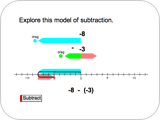 Right or Left: Adding and Subtracting Integers
Right or Left: Adding and Subtracting Integers
Students add and subtract integers using animations on a number line and understand that subtracting an integer is the same as adding its opposite.
View Overview  | Download Activity Files (.zip)
| Download Activity Files (.zip)
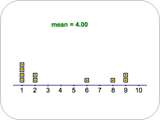 Making Means: Data Distribution and Averages
Making Means: Data Distribution and Averages
Students drag data points on a number line and observe how the mean of their values changes. Students can add, remove, and drag the data points to different locations to create examples of data sets with a given mean.
View Overview  | Download Activity Files (.zip)
| Download Activity Files (.zip)
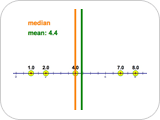 Mean Meets the Median: Measures of Central Tendency
Mean Meets the Median: Measures of Central Tendency
Students drag a fixed number of data points to different locations on a number line and observe the effects on the median and the mean. Students can explore the difference in the median that occurs between having an even and odd number of data points. The emphasis of the activity is not so much on calculating the values of the mean or median given a data set, but on understanding how the mean and median behave depending both on how the data is distributed and on the number of data points.
View Overview  | Download Activity Files (.zip)
| Download Activity Files (.zip)
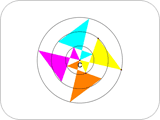 Making a Kaleidoscope: Exploring Rotations
Making a Kaleidoscope: Exploring Rotations
Students create virtual kaleidoscopes by rotating quadrilaterals and then animating them. Students learn that rotated figures keep their size and shape; only their orientation changes. Students make a variety of kaleidoscopes, each with a different number of quadrilaterals and amount of rotation.
View Overview  | Download Activity Files (.zip)
| Download Activity Files (.zip)
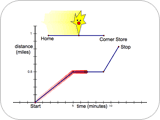 Mellow Yellow: Interpreting Graphs
Mellow Yellow: Interpreting Graphs
Students interpret linear piecewise time-distance graphs that represent different stories about a character, Mellow Yellow. They decide whether a given graph corresponds to the motions (walking fast, walking slow, stopping, going backward) described in the story. Students then create stories based on given graphs and create graphs based on given stories.
View Overview  | Download Activity Files (.zip)
| Download Activity Files (.zip)
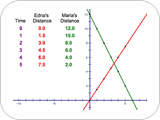 Hikers: Solving Through Multiple Representations
Hikers: Solving Through Multiple Representations
Students use tables, graphs, and equations to represent and solve a real-world problem about two hikers walking at different speeds in opposite directions along the same trail.
View Overview  | Download Activity Files (.zip)
| Download Activity Files (.zip)
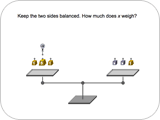 Balancing with Balloons: Solving Equations with Negatives
Balancing with Balloons: Solving Equations with Negatives
Students use a Sketchpad pan balance model to solve a sequence of equations with positive numbers and variables, represented by weights, and negative numbers and variables, represented by balloons. As the problems increase in difficulty, students transfer the manipulation of the pan balance to solving equations independent of the balance.
View Overview  | Download Activity Files (.zip)
| Download Activity Files (.zip)
 Quadrilateral Pretenders: Classifying Quadrilaterals
Quadrilateral Pretenders: Classifying Quadrilaterals
Students drag edges and vertices of various Sketchpad quadrilaterals to discover which are constructed to have specific characteristics. As they make distinctions on the basis of characteristics, they deepen their understanding of the definitions of various quadrilaterals, their properties, and the relationships among them.
View Overview  | Download Activity Files (.zip)
| Download Activity Files (.zip)
 Parallel Pairs: Parallelogram and Triangle Area
Parallel Pairs: Parallelogram and Triangle Area
Students explore the relationship between the areas of parallelograms and triangles using a process called shearing. Students discover that shearing does not affect the area, but changing the lengths of the height and base does. Based on their observations, students write formulas for area of a parallelogram and area of a triangle.
View Overview  | Download Activity Files (.zip)
| Download Activity Files (.zip)
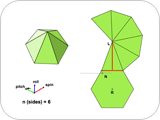 Pyramid Dissection: Surface Area
Pyramid Dissection: Surface Area
Students find the surface area of a regular pyramid (a pyramid with a regular polygon base) using a net that appears along a three-dimensional view of the pyramid. They ensure the generality of their results by changing the dimensions and number of faces of the base. By increasing the number of faces, students extend their results to the surface area of a cone, giving them an informal opportunity to think about limits.
View Overview  | Download Activity Files (.zip)
| Download Activity Files (.zip)
Back to Sample Activities







